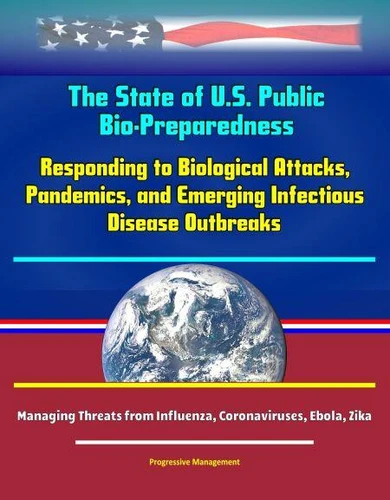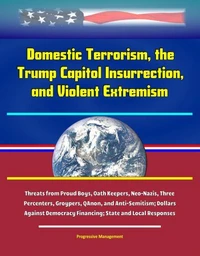The State of U.S. Public Health Bio-Preparedness: Responding to Biological Attacks, Pandemics, and Emerging Infectious Disease Outbreaks - Managing Threats from Influenza, Coronaviruses, Ebola, Zika
Par :Formats :
Disponible dans votre compte client Decitre ou Furet du Nord dès validation de votre commande. Le format ePub est :
- Compatible avec une lecture sur My Vivlio (smartphone, tablette, ordinateur)
- Compatible avec une lecture sur liseuses Vivlio
- Pour les liseuses autres que Vivlio, vous devez utiliser le logiciel Adobe Digital Edition. Non compatible avec la lecture sur les liseuses Kindle, Remarkable et Sony
 , qui est-ce ?
, qui est-ce ?Notre partenaire de plateforme de lecture numérique où vous retrouverez l'ensemble de vos ebooks gratuitement
Pour en savoir plus sur nos ebooks, consultez notre aide en ligne ici
- FormatePub
- ISBN978-0-463-16347-4
- EAN9780463163474
- Date de parution27/01/2020
- Protection num.pas de protection
- Infos supplémentairesepub
- ÉditeurBluewater
Résumé
This hearing of the U. S. House of Representatives continued its longstanding oversight of the U. S. public health system's preparedness to respond to biological threats and emerging infectious diseases that endanger the public health. Witness testimony came from Rick A. Bright, Ph. D., Director, Biomedical Advanced Research and Development Authority; Deputy Assistant Secretary, Office of the Assistant Secretary for Preparedness and Response, U.
S. Department of Health and Human Services; Anne Schuchat, M. D. (RADM, USPHS), Principal Deputy Director, Centers for Disease Control and Prevention, U. S. Department of Health and Human Services; Anthony Fauci, M. D., Director, National Institute of Allergy and Infectious Diseases, National Institutes of Health; and Denise Hinton (RADM, US PHS), Chief Scientist, U. S. Food and Drug Administration.
There was discussion of coronaviruses and influenza viruses, which were termed "the most significant viral pandemic threats to the human population" in the future. The biological threats facing the United States in today's global society are varied, ever-evolving, and in some cases, intensifying. Seasonal influenza claimed the lives of 172 children during the most recent flu season, making it the deadliest seasonal flu season for children on record.
In recent years the U. S. has also seen an increase in the number of antibiotic resistant bacteria. Around the world, viruses are emerging, adapting, and in some cases, re-emerging. Currently, there is an Ebola outbreak in West Africa and a Nipah virus outbreak in India, that has killed at least 17 people. In recent years, we have also seen humans in China contract the H7N9 strain of influenza, which had been confined to birds.
The H7N9 influenza strain is rated by the CDC's Influenza Risk Assessment Tool as posing the greatest risk to cause a possible pandemic. For example, do we have adequate medical countermeasures in place to respond quickly when an outbreak occurs or a toxin is released? Do we have the capacity to quickly deliver these counter-measures to the doctors and nurses who will actually use them? And do the healthcare workers understand how to deploy the countermeasures? Similarly, research into emerging pathogens and existing pathogens that have mutated is key to helping us quickly respond to new and expanding outbreaks.
How is this research informing our surveillance and detection methodologies? Are we prioritizing research into threats of greatest concern? And are we dedicating adequate resources to the threats?This compilation includes a reproduction of the 2019 Worldwide Threat Assessment of the U. S. Intelligence Community.
S. Department of Health and Human Services; Anne Schuchat, M. D. (RADM, USPHS), Principal Deputy Director, Centers for Disease Control and Prevention, U. S. Department of Health and Human Services; Anthony Fauci, M. D., Director, National Institute of Allergy and Infectious Diseases, National Institutes of Health; and Denise Hinton (RADM, US PHS), Chief Scientist, U. S. Food and Drug Administration.
There was discussion of coronaviruses and influenza viruses, which were termed "the most significant viral pandemic threats to the human population" in the future. The biological threats facing the United States in today's global society are varied, ever-evolving, and in some cases, intensifying. Seasonal influenza claimed the lives of 172 children during the most recent flu season, making it the deadliest seasonal flu season for children on record.
In recent years the U. S. has also seen an increase in the number of antibiotic resistant bacteria. Around the world, viruses are emerging, adapting, and in some cases, re-emerging. Currently, there is an Ebola outbreak in West Africa and a Nipah virus outbreak in India, that has killed at least 17 people. In recent years, we have also seen humans in China contract the H7N9 strain of influenza, which had been confined to birds.
The H7N9 influenza strain is rated by the CDC's Influenza Risk Assessment Tool as posing the greatest risk to cause a possible pandemic. For example, do we have adequate medical countermeasures in place to respond quickly when an outbreak occurs or a toxin is released? Do we have the capacity to quickly deliver these counter-measures to the doctors and nurses who will actually use them? And do the healthcare workers understand how to deploy the countermeasures? Similarly, research into emerging pathogens and existing pathogens that have mutated is key to helping us quickly respond to new and expanding outbreaks.
How is this research informing our surveillance and detection methodologies? Are we prioritizing research into threats of greatest concern? And are we dedicating adequate resources to the threats?This compilation includes a reproduction of the 2019 Worldwide Threat Assessment of the U. S. Intelligence Community.
This hearing of the U. S. House of Representatives continued its longstanding oversight of the U. S. public health system's preparedness to respond to biological threats and emerging infectious diseases that endanger the public health. Witness testimony came from Rick A. Bright, Ph. D., Director, Biomedical Advanced Research and Development Authority; Deputy Assistant Secretary, Office of the Assistant Secretary for Preparedness and Response, U.
S. Department of Health and Human Services; Anne Schuchat, M. D. (RADM, USPHS), Principal Deputy Director, Centers for Disease Control and Prevention, U. S. Department of Health and Human Services; Anthony Fauci, M. D., Director, National Institute of Allergy and Infectious Diseases, National Institutes of Health; and Denise Hinton (RADM, US PHS), Chief Scientist, U. S. Food and Drug Administration.
There was discussion of coronaviruses and influenza viruses, which were termed "the most significant viral pandemic threats to the human population" in the future. The biological threats facing the United States in today's global society are varied, ever-evolving, and in some cases, intensifying. Seasonal influenza claimed the lives of 172 children during the most recent flu season, making it the deadliest seasonal flu season for children on record.
In recent years the U. S. has also seen an increase in the number of antibiotic resistant bacteria. Around the world, viruses are emerging, adapting, and in some cases, re-emerging. Currently, there is an Ebola outbreak in West Africa and a Nipah virus outbreak in India, that has killed at least 17 people. In recent years, we have also seen humans in China contract the H7N9 strain of influenza, which had been confined to birds.
The H7N9 influenza strain is rated by the CDC's Influenza Risk Assessment Tool as posing the greatest risk to cause a possible pandemic. For example, do we have adequate medical countermeasures in place to respond quickly when an outbreak occurs or a toxin is released? Do we have the capacity to quickly deliver these counter-measures to the doctors and nurses who will actually use them? And do the healthcare workers understand how to deploy the countermeasures? Similarly, research into emerging pathogens and existing pathogens that have mutated is key to helping us quickly respond to new and expanding outbreaks.
How is this research informing our surveillance and detection methodologies? Are we prioritizing research into threats of greatest concern? And are we dedicating adequate resources to the threats?This compilation includes a reproduction of the 2019 Worldwide Threat Assessment of the U. S. Intelligence Community.
S. Department of Health and Human Services; Anne Schuchat, M. D. (RADM, USPHS), Principal Deputy Director, Centers for Disease Control and Prevention, U. S. Department of Health and Human Services; Anthony Fauci, M. D., Director, National Institute of Allergy and Infectious Diseases, National Institutes of Health; and Denise Hinton (RADM, US PHS), Chief Scientist, U. S. Food and Drug Administration.
There was discussion of coronaviruses and influenza viruses, which were termed "the most significant viral pandemic threats to the human population" in the future. The biological threats facing the United States in today's global society are varied, ever-evolving, and in some cases, intensifying. Seasonal influenza claimed the lives of 172 children during the most recent flu season, making it the deadliest seasonal flu season for children on record.
In recent years the U. S. has also seen an increase in the number of antibiotic resistant bacteria. Around the world, viruses are emerging, adapting, and in some cases, re-emerging. Currently, there is an Ebola outbreak in West Africa and a Nipah virus outbreak in India, that has killed at least 17 people. In recent years, we have also seen humans in China contract the H7N9 strain of influenza, which had been confined to birds.
The H7N9 influenza strain is rated by the CDC's Influenza Risk Assessment Tool as posing the greatest risk to cause a possible pandemic. For example, do we have adequate medical countermeasures in place to respond quickly when an outbreak occurs or a toxin is released? Do we have the capacity to quickly deliver these counter-measures to the doctors and nurses who will actually use them? And do the healthcare workers understand how to deploy the countermeasures? Similarly, research into emerging pathogens and existing pathogens that have mutated is key to helping us quickly respond to new and expanding outbreaks.
How is this research informing our surveillance and detection methodologies? Are we prioritizing research into threats of greatest concern? And are we dedicating adequate resources to the threats?This compilation includes a reproduction of the 2019 Worldwide Threat Assessment of the U. S. Intelligence Community.























